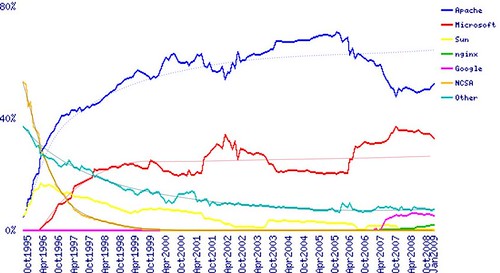(followup post of “the dynamics of OSS adoption – 1“)
The most common process behind OSS adoption is called “diffusion”, and is usually modelled using a set of differential equations. It is based on the idea that the market is made of a set of interoperating agents, each one deciding independently which technology to adopt in different moments; the model is usually capable of handling multiple participants in a market, and to predict overall evolution. A good example of a diffusion-based dynamic equilibrium is the web server market, when total server numbers are used. If we take the data from Netcraft, and we model each individual server type as a competitor, we got this kind of graph:
Which is consistent with a traditional Bass Model explanation (data for apache was added to that of Google Web server, that is Apache-based; bicubic smoothing was used to get the trend lines). Diffusion models tend to generate this kind of equilibrium lines, with the market that in a more or less consistent way moves to an equilibrium that changes only when a specific technology is substituted by moving to another, different status.
The probability of choosing one technology over the other depends on several factors; a very good model for such adoption is the UTAUT model (some pdf examples here and here), that was found capable of predicting 70% of the variance of adoption success (what it means: that the parameters in the model explain nearly perfectly whether you will adopt a technology or not).
The important point to remember: this is about *individual* adoption, not mandated and without external constraints. In this sense, we can use it to predict how a PC owner chooses her web browser, or how a small company may choose which web server to use.
The model uses four parameters: performance expectancy, effort expectancy, social influence, and facilitating conditions.
- performance expectancy: The degree to which a person believes that using a particular system would enhance his or her job performance, or the degree to which using an innovation is perceived as being better than using its precursor.
- effort expectancy: the degree to which a person believes that using a system would be free of effort, or the degree to which a system is perceived as relatively difficult to understand and use.
- social influence: The individual’s internalization of the reference group‘s subjective culture, and specific interpersonal agreements that the individual has made with others, in specific social situations; or the degree to which use of an innovation is perceived to enhance one‘s image or status in one‘s social system.
- facilitating conditions: Reflects perceptions of internal and external constraints on behaviour and encompasses self-efficacy, resource facilitating conditions, and technology facilitating conditions; or objective factors in the environment that observers agree make an act easy to do, including the provision of computer support.
In the next post, I will present an example of these four parameters in the context of an OSS adoption.
